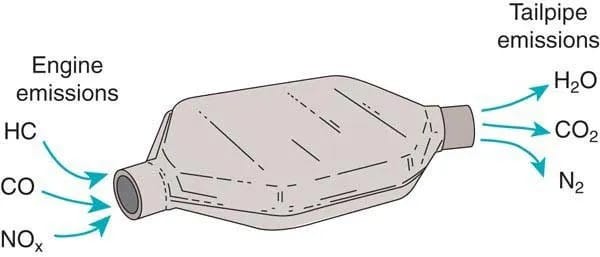Cars, while essential for modern life, produce significant emissions that contribute to air pollution. Regulations like the Clean Air Act in the United States have been crucial in setting standards to mitigate these harmful outputs. A key component in modern vehicles designed to meet these environmental standards is the exhaust system, and within it, a particularly important device: the catalytic converter. This article will delve into the catalytic converter, explaining its function as a critical part of a car’s exhaust system, how it works to reduce pollution, and why it’s so important for both your vehicle and the environment.
What Exactly is a Catalytic Converter?
As mentioned, the catalytic converter is a fundamental part of a car’s exhaust system. Its primary role is to minimize the release of toxic pollutants into the atmosphere. It achieves this by transforming dangerous combustion gases into less harmful substances, primarily water vapor and carbon dioxide.
This transformation occurs through chemical reactions initiated within the converter. Inside, the exhaust fumes are exposed to specific chemicals and precious metals that act as catalysts, encouraging reactions that convert toxic pollutants into more benign forms. Let’s explore the precise function of this crucial component in greater detail.
Decoding the Catalytic Converter’s Function
The core function of a catalytic converter, as a key part of a car’s exhaust system, is to act as a catalyst chamber, altering the harmful compounds present in engine emissions into safer gases, such as steam. It essentially breaks down unsafe molecules within the gases produced by a car engine before they are released into the air we breathe.
Physically, the catalytic converter resembles a large metal box, typically positioned on the underside of a vehicle. It features two pipes: an “input” pipe connected to the engine and an “output” pipe leading to the car’s tailpipe. The process of pollution reduction occurs as follows:
Gases from the engine enter the catalytic converter through the “input” pipe. These gases are then passed over the catalyst material inside the converter. This catalyst initiates a chemical reaction that breaks down the pollutants. The resulting, less harmful gases then exit through the “output” pipe and are expelled through the car’s tailpipe.
The Primary Objective of Catalytic Converters
The fundamental objective of catalytic converters within automotive exhaust systems is to drastically reduce the emission of harmful pollutants from engine exhaust gases, making vehicle operation more environmentally responsible. Their efficiency and reliability are paramount, not only for maintaining optimal vehicle performance but also for actively contributing to broader efforts aimed at minimizing atmospheric pollution and improving air quality.
Inside the Catalytic Converter: Composition and Catalysts
So, what materials make up the catalyst inside this essential part of a car’s exhaust system? The catalyst is typically composed of platinum or similar precious metals such as rhodium or palladium. Exhaust gases flow through a ceramic honeycomb structure housed within the converter. This honeycomb is coated with metals that each play a specific role in emission reduction. Generally, cars utilize two main types of catalysts:
- Reduction catalysts: These are designed to reduce nitrogen oxide pollutants by removing oxygen. Nitrogen oxides are broken down into harmless nitrogen and oxygen gases.
- Oxidation catalysts: These catalysts facilitate the conversion of carbon monoxide into carbon dioxide by adding oxygen.
An important component working in conjunction with the catalytic converter is the oxygen (O2) sensor, often located nearby. This sensor monitors the amount of oxygen in the exhaust gases and transmits this information to the car’s Electronic Control Unit (ECU). This feedback loop enables the vehicle to operate with a more efficient air/fuel ratio, ensuring the engine provides the converter with sufficient oxygen to effectively complete the oxidation process.
Variations in Catalytic Converter Types
As previously mentioned, exhaust systems can incorporate two primary types of catalysts – reduction and oxidation – to manage specific gases.
The configuration of catalytic converters can vary depending on the vehicle’s age and design. Older vehicles may not include a reduction catalyst. There are two main categories of catalytic converters found in cars:
- Two-Way Catalytic Converters: These were standard in vehicles in the United States until 1981. Two-way converters solely utilize oxidation catalysts. They convert carbon monoxide into carbon dioxide and hydrocarbons (unburned or partially burned fuel) into carbon dioxide and water.
- Three-Way Catalytic Converters: Introduced in 1981 and still in use today, three-way catalytic converters build upon the two-way design by adding a reduction catalyst. As mentioned earlier, the reduction catalyst converts nitrogen oxides into nitrogen and oxygen gases, in addition to the functions of a two-way converter.
Diesel engines typically employ two-way catalysts, with converters specifically engineered to handle diesel exhaust. These diesel converters primarily target soluble organic fractions, which are particulates composed of hydrocarbons bound to soot.
The Invention and Evolution of the Catalytic Converter
The concept of the catalytic converter dates back to the late 19th century with early prototypes developed in France. However, it was in the mid-1950s that Eugene Houdry, a French mechanical engineer, significantly advanced the technology. He received a patent for his research into developing catalytic converters for gasoline engines.
Houdry’s motivation stemmed from his concern about the growing air pollution caused by smokestacks and automobile exhaust. Observing studies in Los Angeles highlighting air quality issues, he began developing converters initially for industrial smokestacks.
Further development of catalytic converters was spurred by the implementation of emissions control regulations starting in the early 1960s. The first production catalytic converter for automotive use was created in 1973 by Engelhard Corporation, with widespread adoption in vehicles beginning around 1975.
Protecting Your Catalytic Converter from Theft
Unfortunately, catalytic converters are frequently targeted by thieves due to the valuable precious metals they contain. Vehicles with higher ground clearance are often more susceptible to theft because the converter is more easily accessible.
Regardless of your vehicle type, you can take several precautions to deter catalytic converter theft:
- Park in well-lit areas and, when possible, near building entrances if a secure garage isn’t available.
- Consider having the catalytic converter welded to the vehicle frame, making removal more difficult for thieves.
- Explore purchasing aftermarket protective devices, such as metal cages, designed to cover and safeguard the converter.
- Install a car alarm system equipped with a vibration alert sensor, which can trigger if someone attempts to tamper with the vehicle’s underside.
- Engrave your vehicle identification number (VIN) onto the catalytic converter. This can deter resale and aid in identification if your converter is stolen and later recovered.
Recognizing Signs of Catalytic Converter Problems
Given its critical role within the car’s exhaust system, a malfunctioning catalytic converter can lead to various noticeable symptoms. Recognizing these signs early can help prevent more significant issues.
Some common indicators of catalytic converter problems include:
- Reduced Fuel Efficiency: A clogged catalytic converter can restrict exhaust flow, forcing the engine to work harder and consume more fuel to compensate. This often results in a noticeable decrease in your car’s miles per gallon.
- Check Engine Light Illumination: Modern vehicles manufactured after 1996 have sophisticated diagnostic systems that monitor the catalytic converter’s performance. A malfunctioning converter can trigger the check engine light, often due to readings from the air-to-fuel ratio sensors.
- Rotten Egg Smell: Damage within the catalytic converter can hinder its ability to properly convert exhaust gases. This can result in the release of hydrogen sulfide, which has a distinctive sulfuric or “rotten egg” odor.
- Engine Starting Issues: Exhaust gases need to be expelled efficiently. A blocked catalytic converter can impede this process, leading to increased exhaust back pressure. This can make the engine difficult to start, causing sputtering or stalling.
- Poor Acceleration: Similar to starting problems, restricted exhaust flow from a clogged converter can also impair engine performance during acceleration. You might experience sluggishness, jerking, or stalling when trying to accelerate.
- Failed Emissions Test: Many regions require regular vehicle emissions testing. A failing catalytic converter is a common cause for not passing these tests, often accompanied by other symptoms listed above.
Catalytic Converter FAQs
Why are catalytic converters stolen?
The primary reason catalytic converters are targeted for theft is the presence of valuable precious metals within them. Converters typically contain platinum, palladium, and rhodium, which can be profitably sold to metal recyclers.
What materials are inside catalytic converters?
A standard catalytic converter usually contains approximately 3 to 7 grams of platinum, 2 to 7 grams of palladium, and 1 to 2 grams of rhodium.
What is the monetary value of a catalytic converter?
Recyclers typically pay between $50 and $250 for a standard catalytic converter. However, converters from hybrid vehicles can fetch higher prices, ranging from $800 to $1,500 due to their higher precious metal content. Replacing a stolen catalytic converter can cost around $2,000, highlighting the financial impact of theft and the importance of preventative measures.
How long is the typical lifespan of a catalytic converter?
Catalytic converters are designed to last a significant duration, typically between 70,000 and 100,000 miles. However, their actual lifespan can vary based on factors such as vehicle type, driving habits, and vehicle maintenance.
Can a catalytic converter be cleaned or repaired?
While cleaning a catalytic converter is sometimes possible, repair is generally not a viable option due to its intricate construction and the materials used. Cleaning involves using specialized chemical treatments to remove carbon and other deposits, potentially restoring some functionality, particularly if the damage is not extensive. However, significant physical damage or severe clogging, often resulting from internal melting or component breakdown, usually necessitates complete replacement of the catalytic converter.
Learn More About Exhaust Systems and Automotive Technology
If you’re fascinated by the inner workings of vehicles and components like the catalytic converter part of a car’s exhaust system, a career in the automotive industry might be a rewarding path.
Institutions like the Universal Technical Institute (UTI) offer comprehensive Automotive Technology programs that can equip you with the skills and knowledge needed to become a qualified automotive technician. These programs provide in-depth training on exhaust systems, catalytic converters, and a wide range of other vehicle systems.
To explore your options and learn more about automotive technology careers, you can request additional information from UTI or contact them directly. Taking the first step towards a career as a mechanic or technician could be closer than you think.
READ MORE: 8 Questions to Ask When Choosing An Automotive Mechanic School
START YOUR AUTOMOTIVE CAREER TODAY.
With frequent class start dates, you don’t have to wait to begin your journey.
Hands-on training: Gain practical experience with industry-leading equipment and brands.
No Commitment Pressure: Get your questions answered without any obligation.
Related Articles
[
How Long Does It Take to Become an Automotive Mechanic?](/blog/education/automotive-technician-career)
Explore the path to becoming an auto mechanic and how training at UTI can launch your career!
[
The Difference Between an Automotive Mechanic and an Automotive Technician](/blog/automotive/the-difference-between-a-mechanic-and-an-automotive-technician)
Understand the distinctions between automotive mechanics and technicians and why these differences matter.
[
Automotive Technician Salary in the U.S. – A 2024 Guide](/blog/automotive/technician-salaries)
Discover current salary trends for automotive technicians across the United States.
Disclaimer: Please note the disclaimers regarding UTI program outcomes and approvals as mentioned in the original article.

